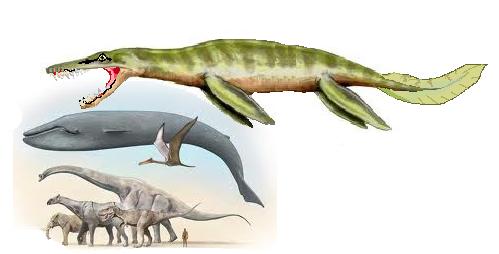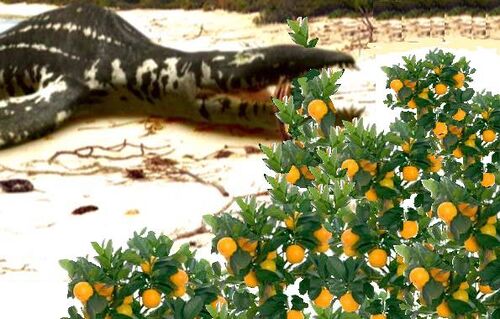Liopleurodon
Liopleurodon is a collective term used to describe any of three different animals in the plesiosaur family. The differences between the three species (Liopleurodon iiziiziji-mainuyuih, Liopleurodon tiberius, and Liopleurodon bulgaughi) are for the most part very subtle and mostly center around differences in the curvature of their incisors and slight differences in their pelvic girdles and as a result this article will simply refer to all three as Liopleurodon. Adult males of all species may attain the length of fifteen school buses and a weight of over one-hundred tons. Females usually top out at only 65 feet long and a weight of 50 tons and the female of Liopleurodon tiberius tops out even larger than the male at 2 tons and nearly 23 feet in length. All Liopleurodons have hundreds of teeth that may grow over nine feet long.
Behavior and Diet[edit]
All Liopleurodons love to sing. They often sing for hours at a time. When they are bored, they'll burst into song. When they're bored of singing, they listen to others sing. They sing in the evening. They sing as the sun rises. As they disembowel a whale they sing softly to themselves. When swallowing a whale whole they sing loudly to themselves. The only time a Liopleurodon doesn't sing is when it is dead. Dead Liopleurodons do not sing. Also, all Liopleurodons are ungodly horrible at singing. They also are predominately aquatic, that is to say they spend considerable amounts of time in a wet environment. Creatures that sing often in wet environments may scare away prey because sound travels faster in water than in air. Thus, they sometimes stop singing when hunting prey, mainly other predominately aquatic organisms like manatees, pacific white-sided dolphins, ground coffee ( heaping piles of it) and the occasional small child, which they relish greatly. The animals require only one small meal each day, usually a large tuna or a shark, but in times of plenty they can consume upwards of 185 tons of meat, and can dislocate their jaw in the manner of a python to swallow something three times as wide as their head, like a pod of blue whales or an average American man, in a single gulp.
However, the Liopleurodon is an opportunistic creature and as such has no inhibitions against eating plant matter, collected with it's long, sticky yellow tongue which is covered in venomous barbs. In times where food is running short, Liopleurodons have been known to haul themselves from the water and delicately nibble individual leaves and berries from trees in a distinctly frightening fashion like a disgustingly overgrown, tree-browsing sea turtle. It takes upwards of five-hundred tons of leaves to equal the calories in a ton of whale blubber, so the Liopleurodon still will lose considerable amounts of weight when prey is in short supply. However, this does no damage to the animal, which is not in any danger until it loses upwards of 95 tons, which would take 15 years of not eating to happen. Thus, many, many of the animals starve to death each year, because even going a single day without flesh can be fatal.
Liopleurodon breed only every 25 years and only after they attain 160 years of age. However, they may live for upwards of 800 years. The male, with his 55 foot long penis, woos the female into getting busy with him through his most wonderful song - it is beautiful and melodic and sounds somewhat like a cross between a canary, a howler monkey being eaten by a giant screeching centipede, a velociraptor killing a little girl, and a thousand cats being set on fire. If he is successful, the two will embrace for up to a month before she eats him. She gives birth to between thirty and forty live young after a fourteen-year pregnancy. The young are born the size of mice and completely defenseless. It takes 25 years for the mother Liopleurodon to nurture and raise their young. They will be nearly as big as their mother by the end of the first month and by that time the next year will be fully grown. The young animals then stay with their mother for around 23 more years, preventing her mating again, practicing their songs over and over again relentlessly all day and night, and demanding twice-hourly 500 pound feedings of penguin meat for the entire time even though they are perfectly capable of looking after themselves.
One widely known fact about the Liopleurodon is that most growing males tend to have seizures to mark the beginning of maturity. Every year, the Liopleurodons meet at the usual mating grounds to have a circle jerk seizure ceremony for the prepubescent teenagers. After the teens preform their first seizure, all adults carefully nibble their own penises to poke holes in their dick for the perfect sex. As they nibble, they progressively build up force with the nibbling to the point where they feel as if they are about to chomp their dick off, and that's when the nibbling stops. After the fierce seizure nibble sessions, all Liopleurodons have a religious orgy.
Conservation[edit]
Initially, about 13 years ago, liopleurodon populations numbered over four-hundred million (an average of one every sixteen feet throughout all of the world's bodies of water excluding the Atlantic Ocean and three small ponds in Arkansas.) However, in late 1999, a man with a name did a thing and then a woman with some hair did some stuff and soon only 2 liopleurodons remained - one juvenile male who had no eyes and only one flipper in Lake Michigan and one very old female lacking any teeth in a sewage-filled ditch in Beijing, China. Luckily, thanks to extensive conservation on the part of the World Wildlife Fund and Nickelodeon, numbers have risen to upwards of 800 million individuals and the population is expected to continue to double annually.


